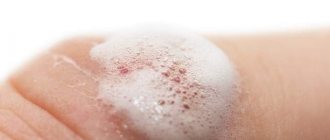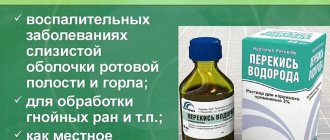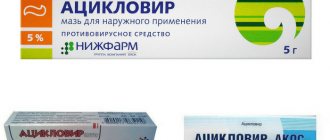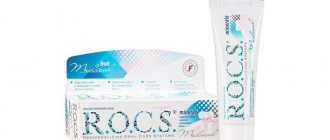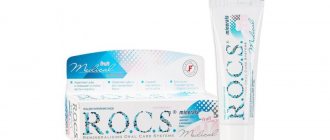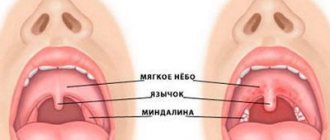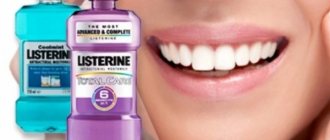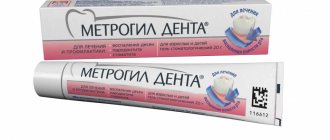It is impossible to imagine a modern country house or cottage without a swimming pool. An artificial pond not only helps to cool off during the summer heat, but also allows you to keep your entire body in good shape. However, over time, debris accumulates in stagnant water and various deposits, microorganisms, bacteria, and harmful substances appear, which rapidly multiply under the influence of high temperatures. Special disinfectants help make caring for the contents of the tank easier. Hydrogen peroxide or perhydrol for the pool is recognized as a relatively new and effective product, instructions for use and dosage of which you will find in our review.
Dihydrogen dioxide: features
The foreign name, which can most often be found on packages in stores, sounds like Hydrogen peroxide; the formulations Dioxidane and Dihydrogen dioxide are also common. In Russian, synonyms are used - hydroperite (if we are talking about tablets or capsules) or perhydrol. This substance is easily soluble in water, alcohol, ether and a number of other liquids. The compound has equally oxidizing and reducing properties: oxidizing nitrites and nitrates, releasing iodines and breaking down proteins, reducing manganese, gold and silver salts. This is precisely the reason for the use of hydrogen peroxide for pools with shallow, small-volume tanks. Once in the environment, it quickly decomposes, which ensures its relative safety, and is also stored for a long time without losing its properties. The substance is widely used in industry, agriculture, medicine and in everyday life. For reservoirs it is used as an effective, powerful disinfectant, bleaching, bactericidal agent with instant action.
5 Reasons Why Add Hydrogen Peroxide to Your Pool
Perhydrol has redox properties, thanks to which the product can be used to clean a home pool. Since an artificial pond requires regular maintenance for health reasons, it is worth listing the reasons explaining the need to use peroxide.
- Destruction of pathogenic microorganisms. Peroxide fights fungi, viruses, bacteria, and mold spores through oxidation processes. When oxygen atoms interact with pathogen cells, the cell walls are destroyed, which leads to the death of pathogens.
- Elimination of organic contaminants. In addition to debris, substances that are left behind by vacationers accumulate in the water: particles of skin, sweat, self-tanning, cosmetics. As a result of oxidative processes, they are easily removed by the filter system.
- Water purification. To return the water to its natural color, it is necessary to get rid of everything that causes cloudiness, in particular algae. The oxidizing properties of perhydrol make it possible to make water crystal clear, and the effect has a prolonged effect.
- Prevention of plaque formation on the walls of the pool. Peroxide not only eliminates mucus on the walls and its cause, but also protects against plaque formation over a certain period. This is possible due to the formation of active oxygen during the interaction of peroxide with water.
- Prevention of insect larvae. When the water becomes cloudy and green, mosquitoes, flies, and midges begin to actively lay larvae. Thanks to perhydrol, the pool remains suitable for swimming for a long time, since clean water without an unpleasant odor does not attract harmful insects.
On what principle does the substance act?
Dioxidane is a colorless liquid that has no odor. A distinctive property is its rapid solubility in H2O. Chemical formula – H2O2. The molecules are fragile, so they can easily break down into water and oxygen. This is the reason for the use of the drug in swimming containers. The active O2 released quickly destroys any pathogenic microorganisms, leading to the clarification of the water mass and the removal of plaque from the walls. At the same time, the existing acid-base balance is not disturbed, which significantly reduces the cost of further bringing the tank back to normal.
Consequences of using a highly concentrated composition
As mentioned above, peroxide breaks down into oxygen and water. It is also not expensive and does not have an unpleasant odor.
But, if you do not follow clear recommendations for use as a pool cleaner, perhydrol will provoke the following:
- dry skin;
- at increased concentrations – a painful burn;
- if water gets into the mouth and then the stomach, the person will suffer from irritation of the mucous membrane;
- loss of natural hair color.
However, peroxide cannot be called a strong disinfectant. In order to effectively destroy reproducing microorganisms in water, the concentration must be at least 200-300 grams per 1 m3 . This amount of perhydrol is considered harmful to humans.
What type of perhydrol is best to use for a pool?
Experts recommend using the following types of substances: medical 30-40%, technical 60% grade “B” and 37% grade “A”. Naturally, the dosage of each type varies, so you must carefully study the instructions before use. It should be noted that a concentration of 60% is explosive and working with it requires certain skills and knowledge. If the liquid in the container is accidentally contaminated, a chain reaction is initiated, promoting decomposition into water and oxygen and, as a result, heating. Temperatures can rise to 1000 degrees. The released H2O suddenly turns into vapor, the volume of which is 7000 times greater than the original amount of the product. Accordingly, an explosion and breakthrough of the container occurs.
Factors affecting the concentration of the product
To determine the required concentration, a number of factors should be taken into account. First of all, this is the degree of pollution and the volume of the pool. For convenience, the level of pollution can be divided into 3 categories :
- low,
- average,
- high.
Table of relationships between factors and concentration:
The concentration is given per 1000 liters of water.
If concentrated peroxide has been stored for 6 months, its effectiveness when used will be reduced by 10-15% compared to the last time. Therefore, calculations should be made taking into account these losses.
Precautionary measures
Since hydrogen peroxide is a complex chemical compound, before carrying out activities related to its use, a person must ensure his safety:
- Protect exposed skin as much as possible, use gloves and a mask.
- If the composition gets on unprotected areas of the body, immediately rinse them with running water.
- When, after contact with liquid, itching, burning, redness, and especially a burn appear, you should immediately seek medical help.
- The container should be stored away from children and animals.
- You can swim in a pond only 24 hours after disinfection; if the concentration was significant, at least 3 days must pass.
- Cleaning the pool with hydrogen peroxide is recommended no more than once a year.
Frequency of application of disinfection solution
To determine how often to disinfect your pool, you should pay attention to the weather .
For example, if there are many sunny days in a month and the weather is hot, in this case the treatment is carried out 2 times a month. At a temperature of 25C° and a moderate number of sunny days, the frequency can be reduced to 1 time.
It is also worth considering the contamination of the pool. There is no need to wait until it becomes too cloudy.
To determine the degree of contamination, you can take water into a transparent glass container and compare it with clean drinking water . If there is a yellowish tint and an unpleasant odor, it is time to disinfect.
Instructions for use
Disinfection with perhydrol is usually chosen by owners of small bowls with a volume of up to 85 cubic meters. Basic rules that must be followed to successfully complete the job:
- Purchase cleaning agents only in specialized stores from trusted sellers. Inspect the packaging before purchasing. The container must be hermetically sealed and supported by a certificate, label or instruction indicating the date of manufacture, expiration date, methods of use, manufacturer's name, batch number and compliance with the standard or GOST.
- Before you begin, be sure to clean the tank of debris from the surface and of deposits from the walls.
- Prepare rubber gloves and goggles to minimize the likelihood of droplets of a chemical compound getting on your mucous membranes.
- When purifying pool water with hydrogen peroxide at any dosage, it is prohibited to cover the bowl with something so as not to interfere with the free release of oxygen.
- The composition must be filled using a pump in filtration mode. In this case, the water intake tube is lowered into a prepared container with working fluid. If you don’t have a pump, take a watering can and use it to distribute the product at different ends of the container.
- Be sure to inform all family members and guests that swimming is prohibited for a certain period.
When can fertilizing be applied?
Fertilizing with peroxide can be applied periodically. It should not be used more than once a week. During the growing season it is most beneficial for plants. This allows them to grow and become stronger in a shorter time.
Top dressing is used as a general strengthening agent and to treat flowers from various diseases. It is often used when transplanting flowers or planting young plants. It has proven itself to be excellent in picking.
What is the concentration of perhydrol?
Before you begin cleaning the tank, you need to find out how much hydrogen peroxide you need to pour for the pool. Canisters with contents are usually sold in several versions: 10, 20 and 30 liters. The most common types: 37% medical and technical hydroperite, as well as 60% foreign substances. The medical composition is considered cleaner, however, for an artificial reservoir this does not matter. To preserve highly concentrated solutions, sodium pyrophosphate is added inside the aluminum container, which stabilizes the composition.
On the Internet you can find many designed calculators for calculating the required amount of chemistry.
MBFT-75 Membrane for 75GPD
SF-mix Clack up to 0.8 m3/h
SF-mix Runxin up to 0.8 m3/h
Calculating the concentration of hydrogen peroxide for a swimming pool depends on how dirty and how large the bowl is. The temperature of the air and the water mass itself also plays an important role. If the latter is above 27 degrees, then the procedure is highly not recommended. Indicative data is presented in the following table.
| Approximate consumption per cubic meter of liquid (in grams), depending on the level of contamination | ||||
| Percent inclusion of perhydrol | Small | Moderate | Abundant | For preventive measures |
| Up to 39% | from 490 to 690 | from 790 to 1090 | from 1190 to 1390 | 190–290 |
| Up to 61% | from 390 to 490 | 590 | from 690 to 790 | 90–140 |
| Time it will take for the dissolution process | 24 hours | 2 days | 72 hours | 12 hours |
How to properly dilute hydroperite
Having found out whether it is possible to add hydrogen peroxide to the pool and having decided to try the innovative method in your artificial pond, prepare personal protective equipment. Invest in leak-proof rubber gloves and goggles to protect your eyes. Next, select the optimal dosage of the drug, depending on the condition of the water (very or slightly dirty) and the surrounding temperature.
It is recommended to work after sunset, when the heat subsides, since the effectiveness of the chemical compound rapidly decreases at temperatures above 28 degrees. If the amount of substance poured into the bowl is greater than planned, it’s okay, you’ll just need to wait for the end of the processes inside not a day, but 72 hours. It must be taken into account that in a heavily polluted tank, the decomposition period slows down proportionally.
Preparation
The use of hydroperite does not require labor-intensive preparatory measures or the presence of special tools or equipment. All that is required is to carry out simple manipulations to remove deposits and dirt. Before starting the cleaning process, you should use a special net to remove debris from the surface, and then clean the walls and bottom of the bowl with a scraper.
How to properly use perhydrol for a pond
Before using hydrogen peroxide in your pool, you need to measure the pH level. Its value should be between 7.1-7.6. When the indicator is higher, you should first use special chemical reagents to reduce it. You can add them in two ways: manually or using a circulation pump.
How to clean manually
You need to pour the prepared composition into a watering can and pour small doses around the entire perimeter of the container. Experts first advise activating the filtration system to quickly mix the drug with water. Be sure to pour the chemical away from the walls of the tank, otherwise it may damage or discolor the facing material.
How to clean using pumping equipment
Having calculated the dosage of hydrogen peroxide in the pool, the substance can be poured inside using a standard circulation pump. To do this, the container with the working fluid is placed near the container on a ladder or other elevated surface. The hose is immersed inside, and the other end, with a pumping bulb, is 15-25 cm. When the substance is completely pumped, you just need to wait the required period of time and remove the dark deposits from the walls and base. You can select suitable equipment on our website.
How to keep water clean
In order for an artificial reservoir to shine with a crystal clear surface in the sun’s rays, several conditions must be met:
SF-mix manual up to 0.8 m3/h
AMETHYST - 02 M up to 2 cubic meters/day.
Aeration unit AS-1054 VO-90
- do not allow pets to bathe;
- Do not wash kitchen utensils and other items in the bowl;
- promptly remove debris from the surface (leaves, bags, branches, fruits, insects, etc.);
- clean the walls from rust, algae, plaque using special scrapers at regular intervals;
- do not mix the drug with other components;
- Don't miss scheduled cleanings.
We wash floors and clean carpets
To disinfect floors in an apartment, pour 5 liters of water into a bucket, a glass of hydrogen peroxide and wipe with a regular mop. No need to rinse. And if there is a carpet or rug on the floor, there will be a little increase in household chores.
It can be a big nuisance to spill any liquid on the carpet or stain it with paints or chocolate. In a family where children are in charge, everything is possible.
The algorithm of actions is as follows: first, use wet wipes to remove the contaminant itself, then moisten the stain with mixture No. 3, rub with a brush and leave for half an hour. At the end of the procedure, remove any remaining moisture with a dry cotton towel, dry with a hairdryer and vacuum.
Basic mistakes
In order for the use of hydrogen peroxide for swimming pools to proceed without negative consequences, it is necessary to familiarize yourself with the main mistakes that can be made without having experience interacting with such a substance:
- Incorrectly calculated dosage for a specific tank.
- Simultaneous use of several cleaning chemicals, with an interval of 3-5 days recommended.
- Insufficiently thorough preparatory work, when plaque from the walls and debris from the water were not completely removed.
- Replacement of part of the water mass without adding hydroperite to it.
- Poor quality removal of suspensions after the procedure and their further mixing with liquid.
How to spray flowers with a solution, how to dilute it?
Spraying is an important point in caring for flowers. You need to spray flowers at least a couple of times a week. In winter, when indoor humidity is low due to heating and the use of heating devices, spraying must be done more often. Four times is considered the norm.
First, spray the plant stem. Then you need to move on to spraying the lower part with the leaves. Next comes the top part of the leaves. When spraying, you need to slightly lift them up a little.
Constantly spraying flowers brings undeniable benefits:
- new shoots grow faster;
- old, weak, fading leaves become stronger and grow;
- turgor becomes strong;
- the foliage of the flowers begins to grow thicker.
To prepare an aqueous substance to spray flowers, use the following dosage: 1 liter of settled tap water, 10 or 15 drops of peroxide. With frequent spraying, we make the solution weaker, with rare spraying, we make it stronger.
It is not recommended to apply spraying to plants with thin translucent and velvety-shaggy leaves. For example, you cannot spray caladium, violets, pelargonium and other similar flowers. Peroxide should only be applied to them during watering.
Important! If a white coating appears on the leaves, you should immediately stop using peroxide and, especially, chemical additives for plant nutrition.
Advantages and disadvantages of cleaning
Disinfection and treatment of the pool with hydrogen peroxide, like the use of other chemicals, has its pros and cons:
- It is also important that there is no unpleasant odor, which is emitted by most similar drugs.
- Easy to use and does not require expensive equipment or tools.
- Removal of green algae during cleaning.
- Safe for the environment.
- Does not change the water-alkaline balance inside the bowl.
- Relative cheapness of the product.
- Effective after just 24 hours.
Among the disadvantages is the dependence of the effect on temperature (the liquid inside the container should not be heated above 27 degrees).
Alternative: 5 options for replacing hydrogen peroxide for cleaning a pool
If it is not possible or desirable to use an oxygen-containing product, disinfection can be carried out using alternative options instead. Among them, popular chemical preparations deserve attention, as well as installations with different operating principles that effectively disinfect water.
- Chlorine. Used for cleaning artificial reservoirs, regardless of their size. The advantages of chlorination are the speed of obtaining results and the long-lasting effect. If you overdose, the water will acquire a characteristic odor, and there is a risk (higher than that of hydrogen peroxide) of allergies, dry skin and even burns. Cost: 375 rubles per 1 liter.
- Bromine. Suitable for small pools. Unlike chlorine, it does not harm the human body, does not cause an unpleasant odor and can be used in ponds in which children swim. Disadvantages - high cost, high consumption, inability to use for outdoor pools (decomposes under the influence of ultraviolet radiation). How much does it cost: about 2,000 per liter.
- UV treatment. Ultraviolet radiation has a detrimental effect on pathogens, and in a short period of time, while being safe for humans. Under the influence of UV rays, water retains its chemical composition and physical properties. For better results, the method is often combined with chlorination. Prices for such an installation start from 200,000 rubles.
- Ozonation. Disinfection is carried out thanks to ozone - a powerful natural oxidizing agent that perfectly eliminates pathogens, cloudy tints and metal particles in the water. To protect vacationers, it is necessary to strictly observe the ozone concentration. An ozone generator costs about 20,000 rubles.
- Chlorine-free systems. Their work is based on the principles of oxidation. Water purification occurs when passing through a reactor chamber, which contains an ionizer and titanium electrodes. The use of chlorine-free systems improves water quality and almost completely reduces the need for chemicals. How much do they cost: 500,000-3,000,000 rubles.
Answers to the most frequently asked questions
1. What is the frequency of preventive cleanings?
If all calculations were performed correctly and the result is satisfactory, the next cleansing is carried out no earlier than 30 days later.
2. Is it better to use peroxide or chlorine?
Chlorine is the most well-known disinfectant and can quickly destroy most types of bacteria. It is recommended for cleaning swimming pools in almost all sanitary organizations. Hydroperite is a stronger and more effective drug if it is necessary to remove any traces of organic matter, sweat or urine, etc. It does not disinfect as well as chlorine, but it can cope with a small bowl volume. Among its advantages is the absence of odor and influence on pH. The correct answer is: alternate the substance.
3. If there is still liquid left in the container after use, will the opened container lose its properties and the shelf life will be reduced?
No. The concentration decreases very slightly, no more than 0.5% in 30 days.
4. Should peroxide be poured into the reservoir as soon as it is filled with water, or should it wait until it becomes dirty and cloudy?
You can use the drug at the first manifestations of turbidity, but it is better to fill it right away, as a preventive measure - there is no difference.
Main table dispenser AquaPro 919H/RO (hot and cold water)
Main table dispenser AquaPro 929CH/RO (cooling/heating)
Floor dispenser AquaPro 311 (empty, without cooling)
5. If the water mass is heavily polluted, like a swamp, is it worth using the composition?
Yes, but please note that the disinfection period will be longer than usual.
6. What to do if H2O does not become transparent after the events?
There may be several reasons: incorrect dosage, not enough time has passed, there are many impurities of lime and chlorine inside. The liquid should be purchased only from trusted manufacturers, so as not to purchase a fake that will be ineffective.
7. If a certain amount of new water is added to the pool, is it necessary to add hydroperite again?
Preferably as a preventive measure.
8. If a reservoir is chlorinated, after what period is perhydrol added?
Usually no earlier than 5-7 days.
9. If salty liquid is poured into the bowl, is the use of peroxide effective?
No, in this case it is not recommended to use the product.
10. How does the solution affect children and animals. They may accidentally ingest H2O while swimming. Will it do any harm?
At a rate of 700 grams per 1000 liters, the percentage is 0.7 grams per 1 liter. These are the indicators immediately after use. Within a day the concentration decreases significantly. Therefore, it is not recommended to swim only during the action of the chemical compound. In the future, the water mass is safe.
11. After pouring the product inside, should the filter be turned on immediately or wait?
It is better to start it at the same time, since a suspension begins to form in the very first minutes. Keep it clean, as actively formed dirt can quickly clog it.
How does the substance affect the plant?
Hydrogen peroxide has a beneficial effect on plants. A substance with an aqueous solution allows gardeners to accelerate the growth of plants or protect them from death. With the complex use of the solution, one should expect active flower growth and rapid development of buds. With constant use of peroxide, strengthening of the roots and development of a healthy plant trunk are observed. The leaves begin to grow more densely, the buds develop quickly. In case of illness and wilting of the flower, a positive effect is observed. The flower recovers and enters the growth and flowering stage. A solution of water and peroxide cannot harm flowers if it is used strictly for its intended purpose, that is, do not exceed dosages.
Important! The substance must be used in the correct proportions and comprehensively. You cannot limit yourself to just watering or spraying, especially for sick flowers.


